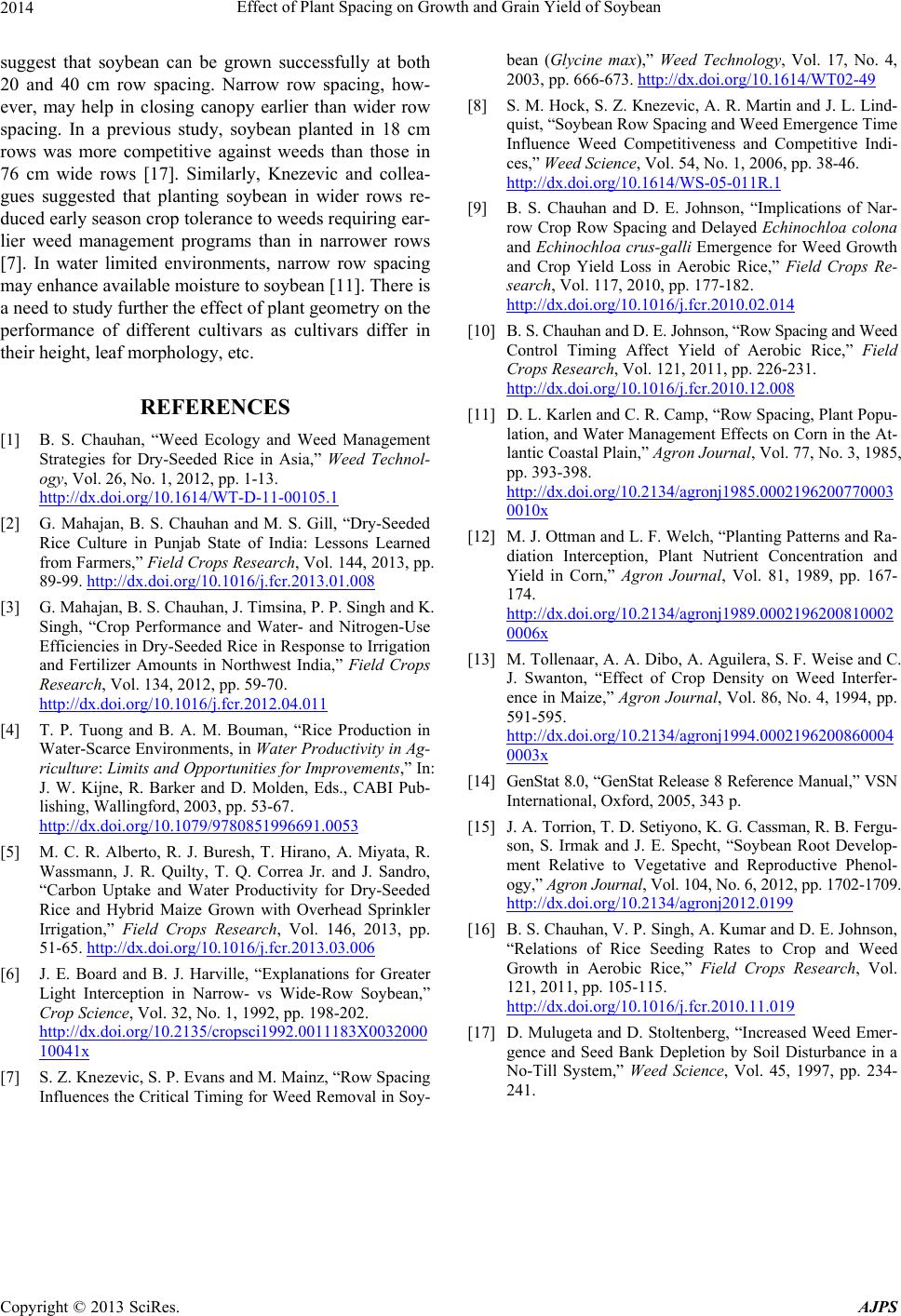
Effect of Plant Spacing on Growth and Grain Yield of Soybean
Copyright © 2013 SciRes. AJPS
2014
suggest that soybean can be grown successfully at both
20 and 40 cm row spacing. Narrow row spacing, how-
ever, may help in closing canopy earlier than wider row
spacing. In a previous study, soybean planted in 18 cm
rows was more competitive against weeds than those in
76 cm wide rows [17]. Similarly, Knezevic and collea-
gues suggested that planting soybean in wider rows re-
duced early season crop tolerance to weeds requiring ear-
lier weed management programs than in narrower rows
[7]. In water limited environments, narrow row spacing
may enhance available moisture to soybean [11]. There is
a need to study further the effect of plant geometry on the
performance of different cultivars as cultivars differ in
their height, leaf morphology, etc.
REFERENCES
[1] B. S. Chauhan, “Weed Ecology and Weed Management
Strategies for Dry-Seeded Rice in Asia,” Weed Technol-
ogy, Vol. 26, No. 1, 2012, pp. 1-13.
http://dx.doi.org/10.1614/WT-D-11-00105.1
[2] G. Mahajan, B. S. Chauhan and M. S. Gill, “Dry-Seeded
Rice Culture in Punjab State of India: Lessons Learned
from Farmers,” Field Crops Research, Vol. 144, 2013, pp.
89-99. http://dx.doi.org/10.1016/j.fcr.2013.01.008
[3] G. Mahajan, B. S. Chauhan, J. Timsina, P. P. Singh and K.
Singh, “Crop Performance and Water- and Nitrogen-Use
Efficiencies in Dry-Seeded Rice in Response to Irrigation
and Fertilizer Amounts in Northwest India,” Field Crops
Research, Vol. 134, 2012, pp. 59-70.
http://dx.doi.org/10.1016/j.fcr.2012.04.011
[4] T. P. Tuong and B. A. M. Bouman, “Rice Production in
Water-Scarce Environments, in Water Productivity in Ag-
riculture: Limits and Opportunities for Improvements,” In:
J. W. Kijne, R. Barker and D. Molden, Eds., CABI Pub-
lishing, Wallingford, 2003, pp. 53-67.
http://dx.doi.org/10.1079/9780851996691.0053
[5] M. C. R. Alberto, R. J. Buresh, T. Hirano, A. Miyata, R.
Wassmann, J. R. Quilty, T. Q. Correa Jr. and J. Sandro,
“Carbon Uptake and Water Productivity for Dry-Seeded
Rice and Hybrid Maize Grown with Overhead Sprinkler
Irrigation,” Field Crops Research, Vol. 146, 2013, pp.
51-65. http://dx.doi.org/10.1016/j.fcr.2013.03.006
[6] J. E. Board and B. J. Harville, “Explanations for Greater
Light Interception in Narrow- vs Wide-Row Soybean,”
Crop Science, Vol. 32, No. 1, 1992, pp. 198-202.
http://dx.doi.org/10.2135/cropsci1992.0011183X0032000
10041x
[7] S. Z. Knezevic, S. P. Evans and M. Mainz, “Row Spacing
Influences the Critical Timing for Weed Removal in Soy-
bean (Glycine max),” Weed Technology, Vol. 17, No. 4,
2003, pp. 666-673. http://dx.doi.org/10.1614/WT02-49
[8] S. M. Hock, S. Z. Knezevic, A. R. Martin and J. L. Lind-
quist, “Soybean Row Spacing and Weed Emergence Time
Influence Weed Competitiveness and Competitive Indi-
ces,” Weed Science, Vol. 54, No. 1, 2006, pp. 38-46.
http://dx.doi.org/10.1614/WS-05-011R.1
[9] B. S. Chauhan and D. E. Johnson, “Implications of Nar-
row Crop Row Spacing and Delayed Echinochloa colona
and Echinochloa crus-galli Emergence for Weed Growth
and Crop Yield Loss in Aerobic Rice,” Field Crops Re-
search, Vol. 117, 2010, pp. 177-182.
http://dx.doi.org/10.1016/j.fcr.2010.02.014
[10] B. S. Chauhan and D. E. Johnson, “Row Spacing and Weed
Control Timing Affect Yield of Aerobic Rice,” Field
Crops Research, Vol. 121, 2011, pp. 226-231.
http://dx.doi.org/10.1016/j.fcr.2010.12.008
[11] D. L. Karlen and C. R. Camp, “Row Spacing, Plant Popu-
lation, and Water Management Effects on Corn in the At-
lantic Coastal Plain,” Agron Journal, Vol. 77, No. 3, 1985,
pp. 393-398.
http://dx.doi.org/10.2134/agronj1985.0002196200770003
0010x
[12] M. J. Ottman and L. F. Welch, “Planting Patterns and Ra-
diation Interception, Plant Nutrient Concentration and
Yield in Corn,” Agron Journal, Vol. 81, 1989, pp. 167-
174.
http://dx.doi.org/10.2134/agronj1989.0002196200810002
0006x
[13] M. Tollenaar, A. A. Dibo, A. Aguilera, S. F. Weise and C.
J. Swanton, “Effect of Crop Density on Weed Interfer-
ence in Maize,” Agron Journal, Vol. 86, No. 4, 1994, pp.
591-595.
http://dx.doi.org/10.2134/agronj1994.0002196200860004
0003x
[14] GenStat 8.0, “GenStat Release 8 Reference Manual,” VSN
International, Oxford, 2005, 343 p.
[15] J. A. Torrion, T. D. Setiyono, K. G. Cassman, R. B. Fergu-
son, S. Irmak and J. E. Specht, “Soybean Root Develop-
ment Relative to Vegetative and Reproductive Phenol-
ogy,” Agron Journal, Vol. 104, No. 6, 2012, pp. 1702-1709.
http://dx.doi.org/10.2134/agronj2012.0199
[16] B. S. Chauhan, V. P. Singh, A. Kumar and D. E. Johnson,
“Relations of Rice Seeding Rates to Crop and Weed
Growth in Aerobic Rice,” Field Crops Research, Vol.
121, 2011, pp. 105-115.
http://dx.doi.org/10.1016/j.fcr.2010.11.019
[17] D. Mulugeta and D. Stoltenberg, “Increased Weed Emer-
gence and Seed Bank Depletion by Soil Disturbance in a
No-Till System,” Weed Science, Vol. 45, 1997, pp. 234-
241.